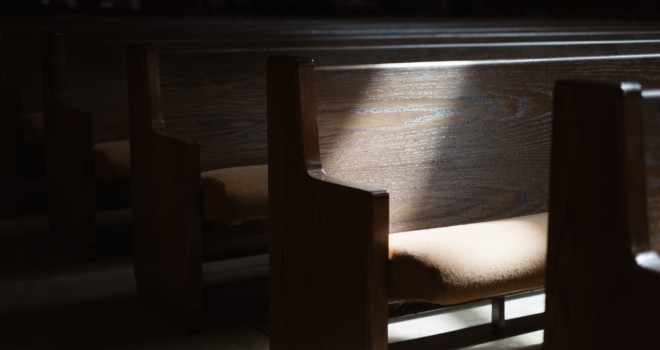It has been almost a year-and-a-half since many American Catholics have regularly attended Sunday Mass. Some have yearned for churches to re-open; while others haven’t really missed Mass at all; and a select group realize: “Gee, I haven’t been to Church and haven’t burst into flames yet!” As churches re-open around the country, bishops, pastors, parish leaders, and parishioners wait anxiously to see how soon and how many people return for Mass. If you are in a Catholic leadership role and think we are going back to a pre-pandemic-normal, you’re likely in for a huge surprise. If you are in this camp, please resume printing the same old number of Sunday bulletins and read no further. If post-COVID Mass attendance leaves you with doubts, discomfort, and unanswered questions, then take heart and lean into the unknown ahead for your parish. This is an ideal time to pivot and do some things differently. But what could that look like?
Over the past two years, a team of colleagues and I have worked in parishes around the country. We’ve had conversations since March 2020 about what churches could do differently after COVID. Some of our ideas were explicit, tactical, and concrete, even measurable. Other discussions focused on potential post-pandemic opportunities and liabilities, navigating ambiguity and many unknowns, revisiting the specific parish mission/vision, and even inviting help from uncommon quarters within parishes upon re-opening. A word of caution: Discernment is needed on most every level of our Church: pastors and parish leaders, parishioners, diocesan leaders, and even the USCCB. As we’ve seen in the past few weeks, the various storms ahead could rival some on the Sea of Galilee. Fear not: We know the Lord is with us.
Most everyone has seen parishes flex and adapt during COVID. Many parishes have livestreamed their Masses, made massive efforts to improve email communication, and update parish websites. All change can be difficult, with most people wanting to ‘stay in the boat as soon as the storm subsides.’ Familiar habits, inertia, and uncertainty can stall the best leaders once severe circumstances diminish and urgency wanes. This is simply human nature. However, this is not the time for our Church to rely solely on human nature. Many inspiring Church leaders rose up in times of great turmoil in the past. Let’s pray for strong leadership to emerge now.
All seasoned leaders know there is no “one size fits all” option for parishes, yet there are assuredly steps that can benefit “most.” Based on my team’s discussions, I’ve comprised a list of potential steps for the days and months ahead. They can help those parishes stuck in maintenance-mode and now looking to energize the parish and slow their rate of contraction. Certain ideas may apply less readily to thriving, mission-focused parishes less hurt by the effects of the pandemic. For both types of parishes, feel free to use, tweak, or modify any approach as you see fit. Ignore suggestions you think outlandish or ones that don’t fall in line with “How we’ve always done things around this parish.” Here are five ideas to consider.
1. Mark a New-Start or Post-Pandemic-Opening (of some sort):
If you simply plan to reopen the parish and return to the way things were in March 2020, you’re probably laying the early foundation for an eventual merger, closure, being subsumed into a neighboring parish or diocesan contraction. Instead, create some way to mark a new start and find the appropriate time to acknowledge we are emerging from a traumatic phase with many losses. For example, most everyone knows a person lost to COVID and many have endured isolation and disruption during the pandemic.
Creating a demarcation or tribute is an opportunity to publicly turn a corner for each parish community. Leadership teams and ministry leaders can discern what’s best for the parish, their congregation size, and in accord with the local COVID restrictions to mark a new beginning. Without a clear and public declaration of some sort, pastors and leaders can appear tone-deaf in sending the latent message that “We are simply going back to normal.” Communities and organizations throughout history have benefited when leaders acknowledged, “We have been through a great trial.”
2. Make All Things New: How can we do this in our parish?
This can be difficult in both conceptualization and implementation. But most every single parish in America can acknowledge there are some things they need to change. The COVID-interruption is an opportunity for our Churches to observe with new eyes what the Lord may want us to do differently. As an example, you can look at things as if your parish is being founded anew. What new ideas might you have? This can prompt the ability to see new possibilities and discern a renewed vision for the parish. A priest told me last year that COVID hasn’t caused challenges for the Catholic Church, it has revealed them. After sixteen months, COVID has accelerated them. Use this opportunity to shift and change things that are not working.
Here’s a question for every Catholic leader: “If you won’t make real and substantive change after COVID, what would ACTUALLY compel you to set a new path for the parish?” Really? What would it take? Let’s hope locusts and frogs are not in your forecast. We know Jesus will be with you, as He makes things new all the time.
3. Pray. Pray. Pray. Pray. Pray. Pray:
Rinse, repeat and pray some more. Pray individually, pray as a parish leadership team, in staff meetings, as school leaders, as Pastoral Councils, pray in Ministry meetings, and as a parish community. You can make “Prayer” a central part of your New-Start & Making All Things New. Praying together, extemporaneously, or OUT LOUD can be unfamiliar and as a result, uncomfortable. Eventually people will grow more confident and inspired in moving beyond rote prayers. Some pastors have used their recent homilies to teach and inspire prayer as we emerge from COVID-time. An invigorated practice of prayer will bear fruit in the coming days, months, and years. Trust in Jesus to help build a bright parish future through prayer. He prayed all the time.
4. Invite Jesus and the Holy Spirit In:
Invoke and invite Jesus and the Holy Spirit in ALL church plans as we emerge from COVID. Pastors can model this in ways that inspire parishioners and the parish leaders to include both Jesus and the Holy Spirit as next steps are discerned. If we’re not willing to do this in new and profound ways: our results will be inconsistent. Effort is needed to incorporate Jesus and the Holy Spirit in partnership with our parishes.
5. Radically Step Up Your Welcoming:
Acknowledge and embrace those who are in the pews at Mass, already showing up, and helping out. These folks are the foundation on which to build and renew churches in the months and years ahead. Most of these people have already asked and answered Jesus’ question in John 6:67 “Do you also want to leave?” They want to stay! Welcome them and appreciate them.
At the same time, do NOT lose heart if people don’t come back right away. Our Church did not arrive at this point because of sixteen months of COVID. This slide took years and will not be fixed in days or weeks. We know many Catholics no longer feel an obligation to attend Sunday Mass. Consequently, we need a greater spirit of invitation in parishes. Give people something to come back to and welcome them when they do show up. Ask your friendliest and most winsome parishioners to serve on the Welcoming Team for 30 or 60 or 90 days. Build a truly welcoming Sunday experience that speaks into the hearts of those who are seeking spiritual comfort now. Do not express overt disappointment or frustration if people do not come back right away. Don’t be disheartened. This is a time to lead with warmth and open heartedness. Reflect on how the father welcomed the Prodigal Son back home.
Priests: see suggestion #4 for homiletic inspiration to be inviting and community-building for those in the pews, checking Facebook, or watching online. Remember Jesus drew many people close to him through his preaching of the Truth.
✠
Photo by Josh Applegate on Unsplash












